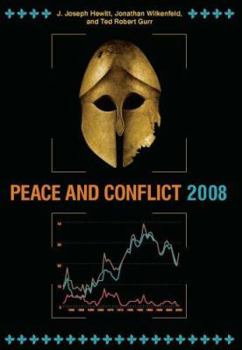Peace and Conflict
Peace and Conflict is a biennial publication that provides key data and documents trends in national and international conflicts ranging from isolated acts of terrorism to internal civil strife to... This description may be from another edition of this product.
Format:Paperback
Language:English
ISBN:1594514011
ISBN13:9781594514012
Release Date:June 2007
Publisher:Routledge
Length:144 Pages
Weight:0.90 lbs.
Dimensions:0.4" x 7.1" x 9.9"
Customer Reviews
1 rating
Useful volume to assess current issues in peace and conflict
Published by Thriftbooks.com User , 16 years ago
Ted Robert Gurr has been an imposing figure in the study of politics. In this volume, he and his co-authors address peace and conflict across the various nations of the world. They provide data that help to make one think a bit. Their basic point (Page 1): "New evidence, and a closer look at old evidence, suggests that if there was a global movement toward peace in the 1990s and early years of the 21st century, it has stalled." This is an edited work, with invited authors addressing a number of issues. The two lengthiest sections are entitled "Regular Features" and "Challenges to the Stability of States." The latter title surely suggests what is at stake in this work. There are a number of tables that illustrate trends well, and make for easier reading by those who are not aficionados of statistics. Take Chapter 2,"The Peace and Conflict Instability Ledger." By looking at a variety of indicators, they rate the states within the "Top 25 highest risk for instability." Who rank at the top? The first five, in order, Afghanistan, Iraq, Niger, Ethiopia, and Liberia. Are you curious which countries are rated the least likely to experience instability? The United Arab Emirates, Finland, and Sweden. Don't get nervous, by the way. The United States rates very low on this, too. Another illustration. . . . Table 4 looks at trends in democratization. For reasons outlined in a couple of my previous books, I'm not quite so sanguine as the others. However, their evidence does suggest that democracy had been moving ahead. In 1977, the number of autocracies was at a high level; the number declined until very recent times. However, there has been a modest increase in the number of countries that have some features of autocracy and some of democracy, states that are more likely to be unstable. And so on. I need not summarize a whole book (a spoiler indeed!). From the above comments, though, it is clear that this book addresses important issues. This is not a standard scholarly work; it should be accessible to interested nonspecialists. I'm not in agreement with a number of points, but this book is a useful resource for those interested in contemporary peace and conflict among nations.






